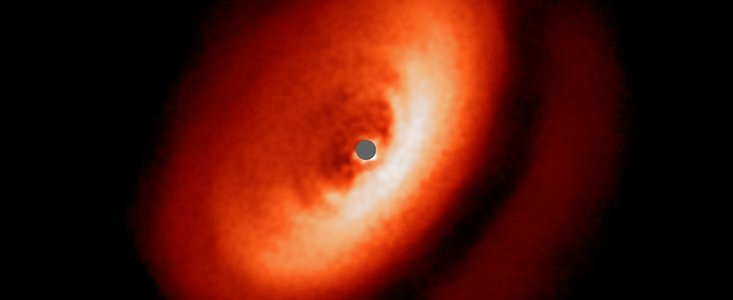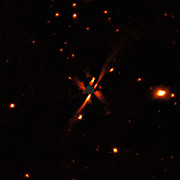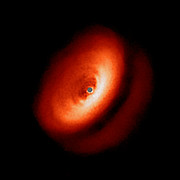Comunicato Stampa
SPHERE rivela uno zoo di dischi intorno alle giovani stelle
11 Aprile 2018
Nuove immagini ottenute con lo strumento SPHERE installato sul VLT (Very Large Telescope) dell'ESO stanno rivelando con un dettaglio mai raggiunto finora alcuni dischi di polvere che circondano giovani stelle vicine: mostrano una bizzarra varietà di forme, dimensioni e strutture, tra cui il probabile effetto dei pianeti che si stanno ancora formando.
Lo strumento SPHERE installato sul VLT (Very Large Telescope) dell'ESO in Cile permette agli astronomi di sopprimere la luce brillante delle stelle vicine per fornire una miglior veduta delle regioni che le circondano. Questa raccolta di immagini di SPHERE è solo un esempio dell'ampia varietà di dischi di polvere che si trovano intorno a giovani stelle. Questi dischi sono molto diversi per dimensione e forma - alcuni contengono anelli brillanti, alcuni anelli scuri e altri assomigliano addirittura a un hamburger. Differiscono notevolemente nell'aspetto anche a seconda della loro orientazione nel cielo - da circolari quando visti di faccia a dischi sottili quando osservati di taglio.
Lo scopo primario di SPHERE è di scoprire e studiare esopianeti giganti in orbita intorno a stelle vicine usando le immagini dirette. Ma questo strumento è anche uno dei migliori strumenti esistenti per ottenere immagini dei dischi intorno a giovani stelle - regioni in cui i pianeti potrebbero essere ancora in formazione. Studiare questi dischi è fondamentale per investigare il legame tra le proprietà del disco e la formazione e la presenza di pianeti. Molte delle giovani stelle mostrate qui provengono da un nuovo studio di stelle di tipo T Tauri, una classe di stelle molto giovani (meno di 10 milioni di anni) e di luminosità variabile. I dischi intorno a queste stelle contengono gas, polvere e planetesimi - i mattoni costitutivi dei pianeti e i progenitori dei sistemi planetari.
Le immagini mostrano anche come avrebbe potuto apparire il Sistema Solare nelle prime fasi della formazione, più di quattro miliardi di anni fa.
La maggior parte delle immagini mostrate qui sono state ottenute nell'ambito della survey DARTTS-S (Discs ARound T Tauri Stars with SPHERE). La distanza dalla Terra delle stelle bersaglio va da 230 a 550 anni luce. Per confronto, la dimensione della Via Lattea è di quasi 100 000 anni luce, perciò queste stelle sono, relativamente parlando, molto vicine alla Terra. Ma anche a questa distanza è molto difficoltoso ottenere buone immagini della debole luce riflessa dai dischi, poichè sommersi nella luce abbagliante delle stelle madri.
Un'altra osservazione di SPHERE ha portato alla scoperta di un disco visto di taglio intorno alla stella GSC 07396-00759, trovato dalla survey SHINE (SpHere INfrared survey for Exoplanets). Questa stella rossa è membro di un sistema multiplo incluso nel campione DARTTS-S ma, stranamente, questo nuovo disco sembra più evoluto rispetto ai dischi ricchi di gas intorno a una stella T Tauri nello stesso sistema, sebbene le due stelle abbiano la stessa età. Questa sconcertante differenza nei tempi scala dell'evoluzione dei dischi intorno a due stelle della stessa età è un altro motivo per cui gli astronomi vogliono scoprire di più sui dischi e sulle loro caratteristiche.
Gli astronomi hanno usato SPHERE anche per ottenere molte altre immagini evocative, così come per altri studi tra cui l'interazione di un pianeta con un disco, i moti orbitali all'interno di un sistema e l'evoluzione temporale di un disco.
I nuovi risultati di SPHERE, insieme ai dati di altri telescopi come ALMA, stanno rivoluzionando la comprensione che gli astronomi hanno dell'ambiente intorno alle stelle giovani e dei complessi meccanismi della formazione planetaria.
Ulteriori Informazioni
Le immagini dei dischi delle stelle di tipo T Tauri sono state presentate nell'articolo intitolato “Disks Around T Tauri Stars With SPHERE (DARTTS-S) I: SPHERE / IRDIS Polarimetric Imaging of 8 Prominent T Tauri Disks”, di H. Avenhaus et al., pubblicato dalla rivista Astrophysical Journal. La scoperta di un disco di taglio invece è presentata nell'articolo intitolato “A new disk discovered with VLT/SPHERE around the M star GSC 07396-00759”, di E. Sissa et al., pubblicato dalla rivista Astronomy & Astrophysics.
Il primo gruppo di autori è composto da Henning Avenhaus (Max Planck Institute for Astronomy, Heidelberg, Germania; ETH Zurich, Institute for Particle Physics and Astrophysics, Zurich, Svizzera; Universidad de Chile, Santiago, Cile), Sascha P. Quanz (ETH Zurich, Institute for Particle Physics and Astrophysics, Zurich, Svizzera; National Center of Competence in Research “PlanetS”), Antonio Garufi (Universidad Autonónoma de Madrid, Madrid, Spagna), Sebastian Perez (Universidad de Chile, Santiago, Cile; Millennium Nucleus Protoplanetary Disks Santiago, Cile), Simon Casassus (Universidad de Chile, Santiago, Cile; Millennium Nucleus Protoplanetary Disks Santiago, Cile), Christophe Pinte (Monash University, Clayton, Australia; Univ. Grenoble Alpes, CNRS, IPAG, Grenoble, Francia), Gesa H.-M. Bertrang (Universidad de Chile, Santiago, Cile), Claudio Caceres (Universidad Andrés Bello, Santiago, Cile), Myriam Benisty (Unidad Mixta Internacional Franco-Chilena de Astronomía, CNRS/INSU; Universidad de Chile, Santiago, Cile; Univ. Grenoble Alpes, CNRS, IPAG, Grenoble, Francia) e Carsten Dominik (Anton Pannekoek Institute for Astronomy, University of Amsterdam, Paesi Bassi).
Il secondo gruppo di autori è composto da: E. Sissa (INAF-Osservatorio Astronomico di Padova, Padova, Italia), J. Olofsson (Max Planck Institute for Astronomy, Heidelberg, Germania; Universidad de Valparaíso, Valparaíso, Cile), A. Vigan (Aix-Marseille Université, CNRS, Laboratoire d’Astrophysique de Marseille, Marseille, Francia), J.C. Augereau (Université Grenoble Alpes, CNRS, IPAG, Grenoble, Francia) , V. D’Orazi (INAF-Osservatorio Astronomico di Padova, Padova, Italia), S. Desidera (INAF-Osservatorio Astronomico di Padova, Padova, Italia), R. Gratton (INAF-Osservatorio Astronomico di Padova, Padova, Italia), M. Langlois (Aix-Marseille Université, CNRS, Laboratoire d’Astrophysique de Marseille Marseille, Francia; CRAL, CNRS, Université de Lyon, Ecole Normale Suprieure de Lyon, Francia), E. Rigliaco (INAF-Osservatorio Astronomico di Padova, Padova, Italia), A. Boccaletti (LESIA, Observatoire de Paris-Meudon, CNRS, Université Pierre et Marie Curie, Université Paris Diderot, Meudon, Francia), Q. Kral (LESIA, Observatoire de Paris-Meudon, CNRS, Université Pierre et Marie Curie, Université Paris Diderot, Meudon, France; Institute of Astronomy, University of Cambridge, Cambridge, Regno Unito), C. Lazzoni (INAF-Osservatorio Astronomico di Padova, Padova, Italia; Universitá di Padova, Padova, Italia), D. Mesa (INAF-Osservatorio Astronomico di Padova, Padova, Italia; University of Atacama, Copiapo, Cile), S. Messina (INAF-Osservatorio Astrofisico di Catania, Catania, Italia), E. Sezestre (Université Grenoble Alpes, CNRS, IPAG, Grenoble, Francia), P. Thébault (LESIA, Observatoire de Paris-Meudon, CNRS, Université Pierre et Marie Curie, Université Paris Diderot, Meudon, Francia), A. Zurlo (Universidad Diego Portales, Santiago, Cile; Unidad Mixta Internacional Franco-Chilena de Astronomia, CNRS/INSU; Universidad de Chile, Santiago, Cile; INAF-Osservatorio Astronomico di Padova, Padova, Italia), T. Bhowmik (Université Grenoble Alpes, CNRS, IPAG, Grenoble, Francia), M. Bonnefoy (Université Grenoble Alpes, CNRS, IPAG, Grenoble, Francia), G. Chauvin (Université Grenoble Alpes, CNRS, IPAG, Grenoble, Francia; Universidad Diego Portales, Santiago, Cile), M. Feldt (Max Planck Institute for Astronomy, Heidelberg, Germania), J. Hagelberg (Université Grenoble Alpes, CNRS, IPAG, Grenoble, Francia), A.-M. Lagrange (Université Grenoble Alpes, CNRS, IPAG, Grenoble, Francia), M. Janson (Stockholm University, Stockholm, Svezia; Max Planck Institute for Astronomy, Heidelberg, Germania), A.-L. Maire (Max Planck Institute for Astronomy, Heidelberg, Germania), F. Ménard (Université Grenoble Alpes, CNRS, IPAG, Grenoble, Francia), J. Schlieder (NASA Goddard Space Flight Center, Greenbelt, Maryland, USA; Max Planck Institute for Astronomy, Heidelberg, Germania), T. Schmidt (Université Grenoble Alpes, CNRS, IPAG, Grenoble, Francia), J. Szulági (Institute for Particle Physics and Astrophysics, ETH Zurich, Zurich, Svizzera; Institute for Computational Science, University of Zurich, Zurich, Svizzera), E. Stadler (Université Grenoble Alpes, CNRS, IPAG, Grenoble, Francia), D. Maurel (Université Grenoble Alpes, CNRS, IPAG, Grenoble, Francia), A. Deboulbé (Université Grenoble Alpes, CNRS, IPAG, Grenoble, Francia), P. Feautrier (Université Grenoble Alpes, CNRS, IPAG, Grenoble, Francia), J. Ramos (Max Planck Institute for Astronomy, Heidelberg, Germania) e R. Rigal (Anton Pannekoek Institute for Astronomy, Amsterdam, Paesi Bassi).
L'ESO (European Southern Observatory, o Osservatorio Australe Europeo) è la principale organizzazione intergovernativa di Astronomia in Europa e di gran lunga l'osservatorio astronomico più produttivo al mondo. È sostenuto da 15 paesi: Austria, Belgio, Danimarca, Finlandia, Francia, Germania, Italia, Paesi Bassi, Polonia, Portogallo, Regno Unito, Repubblica Ceca, Spagna, Svezia, e Svizzera, oltre al paese che ospita l'ESO, il Cile e l'Australia come partner strategico. L'ESO svolge un ambizioso programma che si concentra sulla progettazione, costruzione e gestione di potenti strumenti astronomici da terra che consentano agli astronomi di realizzare importanti scoperte scientifiche. L'ESO ha anche un ruolo di punta nel promuovere e organizzare la cooperazione nella ricerca astronomica. L'ESO gestisce tre siti osservativi unici al mondo in Cile: La Silla, Paranal e Chajnantor. Sul Paranal, l'ESO gestisce il Very Large Telescope, osservatorio astronomico d'avanguardia nella banda visibile e due telescopi per survey. VISTA, il più grande telescopio per survey al mondo, lavora nella banda infrarossa mentre il VST (VLT Survey Telescope) è il più grande telescopio progettato appositamente per produrre survey del cielo in luce visibile. L'ESO è il partner principale di APEX e di ALMA, il più grande progetto astronomico esistente, sulla piana di Chajnantor. E sul Cerro Armazones, vicino al Paranal, l'ESO sta costruendo l'Extremely Large Telescope o ELT (significa Telescopio Estremamente Grande), un telescopio da 39 metri che diventerà "il più grande occhio del mondo rivolto al cielo".
La traduzione dall'inglese dei comunicati stampa dell'ESO è un servizio dalla Rete di Divulgazione Scientifica dell'ESO (ESON: ESO Science Outreach Network) composta da ricercatori e divulgatori scientifici da tutti gli Stati Membri dell'ESO e altri paesi. Il nodo italiano della rete ESON è gestito da Anna Wolter.
Links
- Articolo scientifico (Avenhaus et al.)
- Articolo scientifico (Sissa et al.)
- Pagina web del consorzio SPHERE
- Fotografie del VLT
- Fotografie di SPHERE
Contatti
Henning Avenhaus
Max Planck Institute for Astronomy
Heidelberg, Germany
E-mail: havenhaus@gmail.com
Elena Sissa
INAF - Astronomical Observatory of Padova
Padova, Italy
E-mail: elena.sissa@inaf.it
Richard Hook
ESO Public Information Officer
Garching bei München, Germany
Tel.: +49 89 3200 6655
Cell.: +49 151 1537 3591
E-mail: rhook@eso.org
Anna Wolter (press contact Italia)
Rete di divulgazione scientifica dell'ESO
e INAF-Osservatorio Astronomico di Brera
Milano, Italy
Tel.: +39 02 72320321
E-mail: eson-italy@eso.org
Sul Comunicato Stampa
| Comunicato Stampa N": | eso1811it |
| Nome: | GSC 07396-00759 |
| Tipo: | Milky Way : Star : Circumstellar Material : Disk |
| Facility: | Very Large Telescope |
| Instruments: | SPHERE |
| Science data: | 2018ApJ...863...44A 2018A&A...613L...6S |
Our use of Cookies
We use cookies that are essential for accessing our websites and using our services. We also use cookies to analyse, measure and improve our websites’ performance, to enable content sharing via social media and to display media content hosted on third-party platforms.
ESO Cookies Policy
The European Organisation for Astronomical Research in the Southern Hemisphere (ESO) is the pre-eminent intergovernmental science and technology organisation in astronomy. It carries out an ambitious programme focused on the design, construction and operation of powerful ground-based observing facilities for astronomy.
This Cookies Policy is intended to provide clarity by outlining the cookies used on the ESO public websites, their functions, the options you have for controlling them, and the ways you can contact us for additional details.
What are cookies?
Cookies are small pieces of data stored on your device by websites you visit. They serve various purposes, such as remembering login credentials and preferences and enhance your browsing experience.
Categories of cookies we use
Essential cookies (always active): These cookies are strictly necessary for the proper functioning of our website. Without these cookies, the website cannot operate correctly, and certain services, such as logging in or accessing secure areas, may not be available; because they are essential for the website’s operation, they cannot be disabled.
Functional Cookies: These cookies enhance your browsing experience by enabling additional features and personalization, such as remembering your preferences and settings. While not strictly necessary for the website to function, they improve usability and convenience; these cookies are only placed if you provide your consent.
Analytics cookies: These cookies collect information about how visitors interact with our website, such as which pages are visited most often and how users navigate the site. This data helps us improve website performance, optimize content, and enhance the user experience; these cookies are only placed if you provide your consent. We use the following analytics cookies.
Matomo Cookies:
This website uses Matomo (formerly Piwik), an open source software which enables the statistical analysis of website visits. Matomo uses cookies (text files) which are saved on your computer and which allow us to analyze how you use our website. The website user information generated by the cookies will only be saved on the servers of our IT Department. We use this information to analyze www.eso.org visits and to prepare reports on website activities. These data will not be disclosed to third parties.
On behalf of ESO, Matomo will use this information for the purpose of evaluating your use of the website, compiling reports on website activity and providing other services relating to website activity and internet usage.
Matomo cookies settings:
Additional Third-party cookies on ESO websites: some of our pages display content from external providers, e.g. YouTube.
Such third-party services are outside of ESO control and may, at any time, change their terms of service, use of cookies, etc.
YouTube: Some videos on the ESO website are embedded from ESO’s official YouTube channel. We have enabled YouTube’s privacy-enhanced mode, meaning that no cookies are set unless the user actively clicks on the video to play it. Additionally, in this mode, YouTube does not store any personally identifiable cookie data for embedded video playbacks. For more details, please refer to YouTube’s embedding videos information page.
Cookies can also be classified based on the following elements.
Regarding the domain, there are:
- First-party cookies, set by the website you are currently visiting. They are stored by the same domain that you are browsing and are used to enhance your experience on that site;
- Third-party cookies, set by a domain other than the one you are currently visiting.
As for their duration, cookies can be:
- Browser-session cookies, which are deleted when the user closes the browser;
- Stored cookies, which stay on the user's device for a predetermined period of time.
How to manage cookies
Cookie settings: You can modify your cookie choices for the ESO webpages at any time by clicking on the link Cookie settings at the bottom of any page.
In your browser: If you wish to delete cookies or instruct your browser to delete or block cookies by default, please visit the help pages of your browser:
Please be aware that if you delete or decline cookies, certain functionalities of our website may be not be available and your browsing experience may be affected.
You can set most browsers to prevent any cookies being placed on your device, but you may then have to manually adjust some preferences every time you visit a site/page. And some services and functionalities may not work properly at all (e.g. profile logging-in, shop check out).
Updates to the ESO Cookies Policy
The ESO Cookies Policy may be subject to future updates, which will be made available on this page.
Additional information
For any queries related to cookies, please contact: pdprATesoDOTorg.
As ESO public webpages are managed by our Department of Communication, your questions will be dealt with the support of the said Department.




